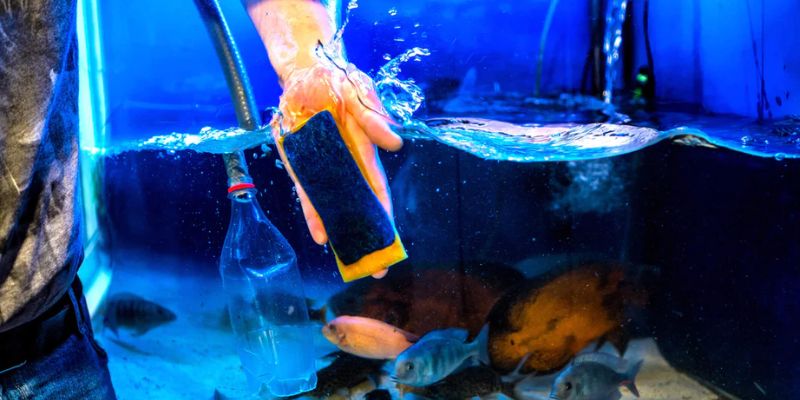Here you can find a wealth of information on how to keep an aquarium’s water at the optimal temperature for your fish. As fish keepers ourselves, we know how crucial it is to keep your aquarium at just the right temperature for your fish and other aquatic companions. In order to provide you with the knowledge and tools you need to keep your fish healthy, this article will go into “How to Monitor and Adjust Water Temperature in a Fish Aquarium?”. Let’s start!
Why Water Temperature is Necessary in a Fish Aquarium?
Fish are not warm-blooded, but rather their body temperature is affected by their immediate environment. Their metabolism, development, immunity, and overall health all depend on the water’s temperature being just right. Temperatures that are too high or too low can cause tension, illness, and even death. As such, it is incumbent upon us as conscientious fish keepers to keep a close eye on the temperature of the water and keep it within the correct parameters.
Preferred Temperature Range and Its Explanation
There are a wide variety of fish species, each of which has its own unique temperature requirements. Learn what sort of range of temperatures your critters of choice prefer. Temperatures between 75 and 80 degrees Fahrenheit (24 and 27 degrees Celsius) are ideal for tropical fish, whereas those between 50 and 70 degrees Fahrenheit (10 and 21 degrees Celsius) are ideal for coldwater fish. Once the optimum temperature range has been established, the water temperature can be tracked and adjusted as needed.
How to Monitor and Adjust Water Temperature in a Fish Aquarium?
It is vital that the water temperature be constantly and accurately monitored. Useful resources include the following:
Aquarium Thermometer
A high-quality aquarium thermometer will provide accurate temperature readings, therefore it’s important to have one. Both analog and digital thermometers are commercially available. Keep the thermometer in the tank’s center, out of direct sunlight and away from any heat sources. This guarantees a reliable depiction of the ocean’s average temperature.
Immersible Thermometer
A submersible temperature probe could be used for more precise tracking. These probes can be connected to a digital display unit located outside the tank to provide real-time temperature measurements. For big aquariums or when extreme precision is required, submersible temperature probes are an invaluable tool.
Adjusting Water Temperature in a Fish Aquarium
The health of your fish depends on your ability to keep the water temperature consistent. Some reliable strategies for modifying the temperature of the water are as follows:
Aquarium Heater
A ubiquitous and useful device, an aquarium heater keeps the water in an aquarium at a constant temperature. Pick a heater that can maintain a steady temperature in your aquarium that meets the needs of your fish. Put the heater in the water and set the thermostat to the ideal temperature for your fish. Keep an eye on the thermostat and make changes as needed.
Cooling Equipment
Cooling devices may be necessary in warmer locations or during the summer months to maintain an appropriate water temperature for your fish. When the temperature is too high, we can use cooling fans, chillers, or even frozen water bottles. Keep a tight eye on the thermostat to make sure the temperature never fluctuates out of the safe zone.
How to Monitor Water Temperature in a Fish Aquarium
Maintaining a clean and safe aquarium for your fish requires constant attention. The following are recommended procedures:
Temperature Must Be Checked Daily
Establish a routine of checking the water temperature on a daily basis using your preferred measuring device. This facilitates the rapid identification of any variations or outliers. whether you want to see whether there are any trends or changes over time, keep a log of the temperatures.
Inspecting the Water’s Quality
The health of your fish depends on more than just the temperature of the water you keep them in. The water should have its pH, ammonia, nitrite, and nitrate levels checked on a consistent basis. The temperature of the water and the condition of your fish may be affected indirectly by imbalances in these parameters.
Heating System Adjustments
The accuracy of your aquarium heater depends on regular calibration. A trusted thermometer can be used to verify the heater’s temperature reading. If the differences are large, you may need to replace or fine-tune the heater.
Contingency Planning
Rapid temperature changes in the aquarium might be caused by unexpected power interruptions or equipment malfunctions. Battery-operated air pumps and backup heating and cooling systems are smart precautions to take. Make sure these secondary systems are regularly tested and in good working order.
Conclusion
Keeping the water at the correct temperature is critical to the well-being of your fish. You can create a healthy ecosystem for your fish by learning the ideal temperature range, monitoring conditions with the right equipment, and making necessary adjustments as needed. Always be ready for the worst case scenario and keep a close eye on the temperature and water quality to make sure your aquatic pets are safe.


https://gajweor.pixnet.net/blog/post/157629580